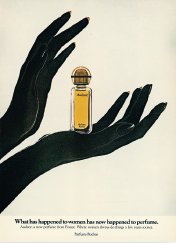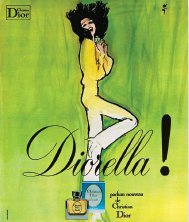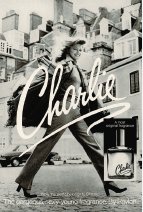Scent and Subversion (20 page)
Read Scent and Subversion Online
Authors: Barbara Herman

by Lanvin (1971)
Bitter greens and powdery, woody florals balance each other out in this chic, put-together perfume. Harder (and greener) than florals today, yet also softer and more powdery, Via Lanvin exposes the balancing act that was femininity at the dawn of the women’s liberation movement. As it dries down, it gets warmer and sweeter (thanks to amber), like a person who takes her time getting to know you before showing a softer side, but its backbone remains wonderfully and bracingly green. An hour or so in, and the most complex and interesting mix of clovey carnation, amber, and moss mingle and continue the perfume’s conversation.
Top notes:
Leafy green, bergamot, aldehyde, violet, lemon
Heart notes:
Lily of the valley, jasmine, orris, carnation, rose, ylang-ylang, narcissus
Base notes:
Vetiver, cedar, sandalwood, musk, amber, moss
(1971)
Weil de Weil starts off with a wonderfully bitter green accord—galbanum, leafy-green notes, and facets from neroli and narcissus. Just as these tart, minor-key notes sing out, Weil subtly evolves into something softer and dreamier, thanks to a plump gardenia and powdery—almost rotten-sweet—hyacinth. The combination of the almost-too-strong hyacinth and leafy-green note (coriander?) mixed with musk, amber, sandalwood, and leather creates a momentary note of perspiration. (I didn’t include civet, but I’ve seen it mentioned.)
Weil de Weil manages to evoke the transformation of spring to summer, of freshness to ripeness, of innocence to the first stirring of erotic desire. Its animalic and woody base notes turn the perfume’s springtime coolness into a hot, languid summer. Or, more accurately, it deconstructs those oppositions and suggests that spring already contains the last days of summer; that innocence always contains experience; and that every beginning has the seeds of its ending.
Top notes:
Galbanum, leafy green, gardenia, hyacinth, neroli
Heart notes:
Rose, orris, jasmine, narcissus, ylang-ylang
Base notes:
Sandalwood, cedarwood, oakmoss, musk, amber, leather
by Estée Lauder (1972)
Perfumer:
Francis Camail
Marketed as a sports fragrance, Aliage is as tart as a zested lemon, with a drop of musky peach and a greener-than-green galbanum note, a perfume whose initial notes soar like high keys in a musical composition. Like Balmain’s Vent Vert in terms of its citrus brightness and galbanum piquancy, Aliage packs a punch.
Aliage is fresh and citrusy, with a forest backdrop of resiny pine, thyme, oakmoss, and vetiver. And there’s a shadow of musk just behind all these bright, fresh notes. A hint of ripe fruit from the peach doesn’t exactly make Aliage sweet, but it does round out and mellow its sharp notes. Aliage is one of the few scents I fantasize about finding the cocktail equivalent of, so I can drink it. Although it’s still being made, I’ve heard the more-modern formulation isn’t the same.
Top notes:
Green notes (galbanum?), citrus oils, peach
Heart notes:
Jasmine, rosewood, thyme, pine needle
Base notes:
Vetiver, myrrh, musk, oakmoss
by Clinique (1972)
Perfumer:
Bernard Chant
Aromatics Elixir, a green chypre, smells like a mixture of dried, pressed roses, coriander, and carnation whose arid herbiness has been reconstituted with a few drops of sweet flower essences. This contrast between dry and sweet rests on a warming, animalic, and spicy base of sandalwood, vetiver, and a heaping dose of patchouli, with its camphoraceous-medicinal, oily darkness.
Aromatics Elixir is so different in style from the prevailing style of clean and fruity that it surprises me it is actually still at the Clinique counter rather than behind museum glass. It has that air about it that Private Collection by Estée Lauder has—that it would rather be admired than loved, described as chic rather than pretty.
When I was a perfume-obsessed tween at the mall, trying on everything I could get my hands on, I remember thinking that Aromatics Elixir stunk to high heaven, and I wondered who would want to smell so harsh, so unlike a flower. That was then …
Top notes:
Bergamot, green notes, coriander, rosewood, aldehyde (palmarosa, a rose-scented species of lemongrass also called Indian geranium)
Heart notes:
Rose de Mai, jasmine, carnation, ylang-ylang, tuberose, orris
Base notes:
Patchouli, vetiver, civet, sandalwood, oakmoss, cistus, musk
by Rochas (1972)

Referencing the women’s movement, this 1972 ad for Rochas’s Audace claims cryptically that “what has happened to women” has also happened to perfume.
A green floral chypre in the style of Sikkim, Fête de Molyneux, and Aramis, Audace is a perfect balance of bracing green, rich florals, and mossiness. In some ways, the International Fragrance Association (IFRA) restrictions—and possible future EU ban—on oakmoss will not matter to perfumes like this. No one is making them, anyway; the style is too old-fashioned for some. As I sniff the drydown on my hand, I seriously question why, and plan on hoarding this stuff.
Notes not available
.
by Christian Dior (1972)
Perfumer:
Edmond Roudnitska
Fur rubbed with mint toothpaste. Vietnamese beef salad. Like fruit on the verge of going bad. More than any other vintage perfume that I’ve encountered, the fresh yet funky-ripe perfume Diorella provokes the most hyperbolic metaphors from perfume critics.

Christian Dior’s Diorella, 1972 (Artist: René Gruau)
Diorella was Roudnitska’s favorite perfume, described by many as similar to Eau Sauvage, but with a drop of peach. If Eau Sauvage is Roudnitska’s overexposed olfactory photograph, and Femme, with its saturated, sueded fruit notes the underexposed one, then Diorella is the perfect picture, bright yet warm.
Kaleidoscopically complex, Diorella starts off citrus fresh and transitions to a body-odor-tinged (cumin-like) floral accord with honeysuckle and jasmine. The musky base adds weight to its sparkling top notes, never wearing Diorella down but rather giving it a little depth and darkness. Like Suzanne from Leonard Cohen’s song, Diorella “shows you where to look / amid the garbage and the flowers,” through its olfactory juxtaposition of ripe smells and floral notes. Diorella smells—this is actually an endorsement—like not-yet-going-bad garbage that someone has thrown a pile of flowers onto.
I even smelled a touch of the notoriously pungent durian fruit in the sweet/rotten undertones of Diorella, or maybe more accurately, jackfruit, which could be an aspect of its melon note.
Honestly, does anyone do “funk” as well as Roudnitska? It’s as if he’s reminding us that these ripe smells connote death as much as they do life, and that it is the mortality of these bright and alive things that makes them beautiful. It’s been said that Diorella was the first perfume to break free from the notion that flowers were wholesome. Whether or not it was the first, I agree that one would definitely think of flowers and citrus fragrances differently after spending some time with Diorella. There’s a living, breathing, dirty animal underneath the clean citrus and the ladylike flowers.
Top notes:
Sicilian lemon, peach, basil, Italian bergamot, lemon, green notes
Heart notes:
Honeysuckle, jasmine, violet, rosebud, carnation, cyclamen
Base notes:
Oakmoss, clove, sandalwood, vetiver, musk, patchouli
by Caron (1972)
Perfumer:
Gerard Lefort
Like a mini Coriandre (1973), rosy and herby Infini by Caron is an edgy floral aldehyde with a distinctly ’70s kind of sophistication.
It starts out with a strong coriander note, which creates an interesting dry counterpoint to the juicy peach, sweet neroli, and rich rose that bloom as the fragrance evolves into its floral heart. Infini then dries down to a wonderful base of woody sandalwood and vetiver, with tonka, musk, ambrein (an ambergris-like extract from cistus labdanum), and civet, the animalic notes adding subtle sexiness and warmth. Hours after I’ve applied it, Infini, befitting its name, seems to go on forever, echoing the faintest rose and coriander veiled by warm base notes.
Top notes:
Aldehyde complex, bergamot, peach, neroli, coriander
Heart notes:
Rosa centifolia,
jasmine, lily of the valley, orris, ylang-ylang, carnation
Base notes:
Sandalwood, vetiver, ambrein, tonka, musk, civet
by Revlon (1973)

Model turned
Charlie’s Angels
actress Shelley Hack confidently struts in slacks through this iconic 1978 ad for Charlie perfume.
Created during the heyday of the women’s movement in the 1970s, Charlie, with its androgynous name, studiously carefree signature, and jaunty green / floral aldehydic personality, could be said to be one of the first feminist fragrances ever created.
I say
feminist
because it was marketed to American women during an era when feminist consciousness was at its pop-culture height, and because it features independent ladies (mainly model turned
Charlie’s Angels
actress Shelley Hack) confidently strutting through print and television ads wearing slacks.
Charlie has some interesting tensions going on within it that make it quite interesting. As a feminist fragrance (just humor me on this one), it seems to be saying, “I can be pretty, independent, and strong.” As a pretty green floral that’s almost a chypre, it’s wearable, and, to my nose, still modern-smelling.
First off, the citrus oils and tarragon give it a bright and slightly green/herby beginning with a minuscule dose of licorice from the tarragon. Its radiant florals are more sporty than they are sexy—the cyclamen and lily of the valley greening the fragrance even more.
In its drydown, I get a whiff of Bandit, arguably the first feminist fragrance in a
pre
feminist era. What do I smell? Something leathery/rubbery, as fragrances with galbanum or isobutyl quinoline would give off. It has a faint chypre-like drydown, which makes sense because of its citrusy top note and oakmoss/sandalwood/cedarwood base notes. Chypres, to me, signify “strong woman,” and Charlie retains a trace of that in the drydown.
Top notes:
Citrus oils, peach, hyacinth, tarragon
Heart notes:
Jasmine, rose, lily of the valley, cyclamen, carnation, orris
Base notes:
Cedarwood, sandalwood, oakmoss, musk, vanilla
